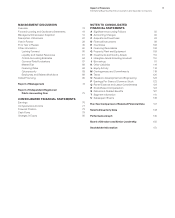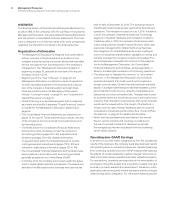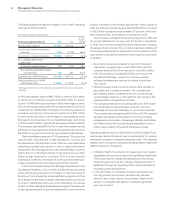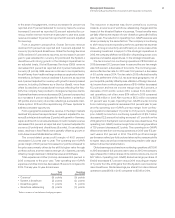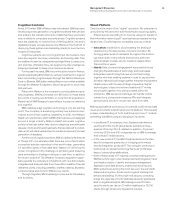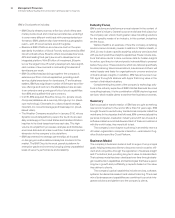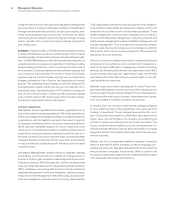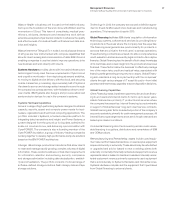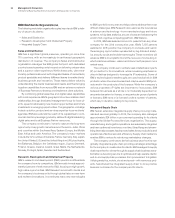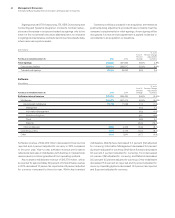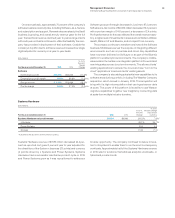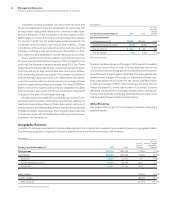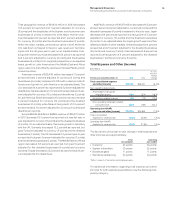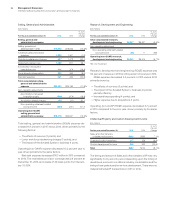IBM 2015 Annual Report Download - page 28
Download and view the complete annual report
Please find page 28 of the 2015 IBM annual report below. You can navigate through the pages in the report by either clicking on the pages listed below, or by using the keyword search tool below to find specific information within the annual report.26 Management Discussion
International Business Machines Corporation and Subsidiary Companies
Global Process Services: (included within Application Management
Services) delivers a range of offerings consisting of standardized
through transformational solutions including processing plat-
forms and business process outsourcing. These services deliver
improved business results to clients through the strategic change
and/or operation of the client’s business processes, applications
and infrastructure.
Software consists primarily of middleware and operating systems
software. Middleware serves as a software layer that connects
operating systems to applications across a standard software plat-
form. The IBM Middleware portfolio allows seamless integration of
unrelated systems, processes, and applications all while providing
market leading functionality, in both on-premise and hybrid cloud
environments. Operating systems are the software engines that
run computers. Approximately 70percent of external Software
segment revenue is annuity based, coming from recurring license
charges, software sold “as-a-Service” and ongoing post-contract
support. The remaining revenue relates to one-time charge (OTC)
arrangements in which clients pay one, up-front payment for a
perpetual license. Typically, the sale of OTC software includes one
year of post-contract support. Clients can also purchase ongoing
post-contract support after the first year, which includes unspec-
ified product upgrades and technical support.
Software Capabilities
WebSphere: delivers capabilities that enable organizations to run
high-performance business applications. With these applications,
clients can integrate and manage business processes across their
organizations with the flexibility and agility they need to respond
to changing conditions. Built on services-oriented architecture
(SOA), and open standards support for cloud, mobile and social
interactions, the WebSphere platform enables enterprises to
extend their reach and optimize interactions with their key con-
stituents. Smarter Commerce software helps companies better
manage and improve each step of their value chain and capitalize
on opportunities for profitable growth, efficiency and increased
customer loyalty.
Information Management: enables clients to integrate, manage
and analyze enormous amounts of data from a large variety of
sources in order to gain competitive advantage and improve their
business outcomes. With this approach, clients can extract real
value out of their data and use it to make better business decisions.
IBM’s middleware and integrated solutions include advanced
database management, information integration, data governance,
enterprise content management, data warehousing, business ana-
lytics and intelligence, predictive analytics and big data analytics.
Tivoli: helps clients optimize the value they get from their infrastruc-
tures and technology assets through greater visibility, control and
automation across their end-to-end business operations. These
asset management solutions foster integrated service delivery
for cloud and datacenter management, enterprise endpoint and
mobile device management, asset and facilities management, and
storage management. Tivoli includes security systems software
that provides clients with a single security intelligence platform
that enables them to better secure all aspects of their enterprise
and prevent security breaches.
Workforce Solutions: enables businesses to connect people and
processes for more effective communication and increased pro-
ductivity through collaboration, messaging and social networking
software. By remaining at the forefront of collaboration tools, IBM’s
social business offerings help organizations reap real benefits
associated with social networking, as well as create a more effi-
cient and effective workforce.
Rational: supports software development for both IT and com-
plex embedded system solutions, with a portfolio of products and
solutions supporting DevOps and Smarter Product Development,
transforming the way lines of business, development and opera-
tions work together to deliver innovation via software.
In January 2015, the company made several changes designed
to more effectively align its key capabilities and resources to its
strategic imperatives. These changes have enabled the com-
pany to respond more quickly to critical client agendas and drive
higher value. Across Software, the company is transitioning its
portfolio to capture growth and continue to drive innovation. The
focus is centered around analytics, security, and commerce, uti-
lizing its software assets to improve speed and agility in bringing
integrated solutions to its clients and to help clients become cog-
nitive enterprises.
Watson: the first commercially available cognitive computing
platform that has the ability to interact in natural language, pro-
cessing vast amounts of big data, and learning from its interactions
with people and computers. As an advisor, Watson is able to sift
through and understand large amounts of data delivering insights
with unprecedented speeds and accuracy.



